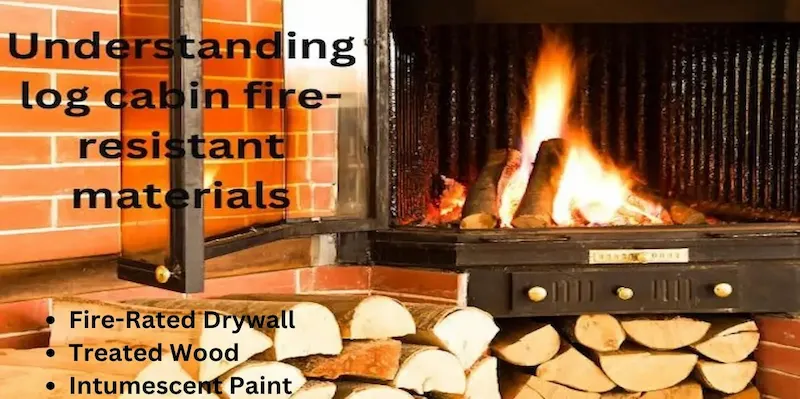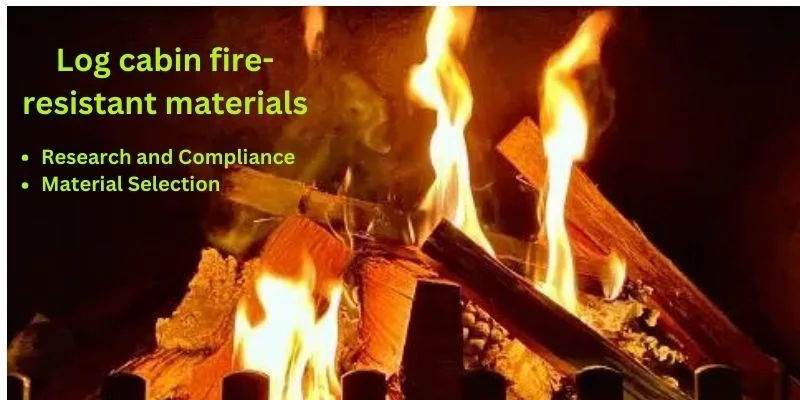Ensure Your Log Cabin’s Safety with Fire-Resistant Materials: 4 Essential Types | Camping Tips
Updated: 4 Feb 2024
232
In the serene, secluded beauty of cabin life, it’s easy to imagine the warmth of a fireplace as the centerpiece of comfort for camping. However, the very elements that make a log cabin so inviting – the wooden construction and the remote surroundings – can create a major fire danger. Log cabin fire-resistant materials play a major role in building a fire-safe cabin.
For campers looking to build or renovate a cabin, ensuring its fire safety is supreme. Using fire-resistant materials is one of the most effective ways to not only meet building codes but also to safeguard your retreat against potential destruction.
Out in the great camping, where nature is shining and people love the simple life, log cabins are like homes for camping fans. But, while we enjoy the peacefulness of these wooden getaways, it’s super important to make sure they’re safe without losing their natural charm. The trick is using materials that can resist fire.
The Importance of Fire-Resistance in Log Cabin Construction
In camping, Building a log cabin that can withstand the threat of fire is crucial, particularly in areas known for dry, fire-prone conditions. A well-constructed cabin with appropriate fire-resistant design and materials can slow the spread of fire, giving firefighters more time to respond and potentially save your property.
Understanding log cabin fire-resistant materials
Fire-resistant materials are those designed to withstand high temperatures without igniting. In the context of log cabin construction, this includes specially treated wood, fire-rated drywall, and insulation that can help protect the structure and its inhabitants in the event of a fire.

Types of log cabin fire-resistant materials in Camping
When you start camping, choosing appropriate materials is a critical step in your fire-safe log cabin project.
Here are some essential types to consider:
1. Fire-Rated Drywall
Interior walls and ceilings should be equipped with fire-rated drywall, which is made with glass fibers to improve fire resistance and prevent the spread of flames. It is offered in various thicknesses may specify the required rating for log cabins during camping.
2. Treated Wood
For wooden elements like beams and timber, using pressure-treated lumber is advisable. This wood is infused with chemicals that resist decay and can also enhance fire resistance when treated with the appropriate fire-retardant solution.
3. Intumescent Paint
For campers, this type of paint expands when exposed to high heat, creating a barrier that insulates the wood beneath and slows the fire’s progress. It is an ideal finish for walls, doors, and other wooden surfaces that might be exposed to fire.
4. Fire-retardant caulks and Sprays
Sealing joints and openings with fire-retardant caulks and sprays is essential. These products can prevent the spread of fire through crevices and small openings that might not initially be addressed by other fire-resistant materials.
Construction Tips for Fire-Resistant Strategy
Starting a log cabin project demands careful planning to integrate fire-resistant practices. Follow these tips to enhance your cabin’s fire resistance:
1. Research and Compliance
Begin by thoroughly researching locations near camping. Understanding and complying with these regulations sets the foundation for a safe log cabin.
2. Material Selection
Consult with a professional to select the appropriate fire-resistant materials for your cabin. The right choices can make a significant difference in protecting your property if a fire occurs.
3. Integrate for Full Coverage
Adopt a comprehensive approach that integrates fire-resistant materials throughout the cabin for camping. Every structure, from the foundation to the roof, should be included in your fire-resistant strategy.

4. Sealing and Maintenance
Proper installation and regular maintenance of fire-resistant materials are as critical as their selection. Over time, materials may degrade, and seals may become ineffective. Regular inspections and maintenance are essential to ensuring the continued protection of your log cabin.
Risks of Inadequate Fire-Safe Measures
Skimping on fire-resistant materials can lead to terrible consequences in the event of a fire. During camping, Surrounded by flames, a poorly protected cabin can become blown in minutes. The use of poor-quality materials not only risks your safety and the loss of your property but can also result in legal penalties.
Pros and cons of Using Log Cabin Fire-Resistant Materials
| Pros: |
|---|
|
| Cons: |
|---|
|
Faqs
Are fire-resistant materials required for all log cabins?
The need for fire-resistant materials may vary depending on your location for camping. However, it is always advisable to incorporate these materials into your log cabin construction.
Is it possible to renovate an existing log cabin with fire-resistant materials?
Yes, it is possible to install fire-resistant materials in an existing log cabin. It is recommended to consult with a professional to determine the best approach for your specific structure.
Are there any eco-friendly options for fire-resistant materials?
Yes, there are several environmentally friendly fire-resistant materials available on the market. It is best to consult with a professional to determine the most suitable options for your log cabin.
Can I install fire-resistant materials myself?
It is always recommended to consult with a professional for the installation of fire-resistant materials. Improper installation can compromise their effectiveness, putting your log cabin at risk.
Conclusion
For campers in camping, building or renovating a log cabin comes with many decisions, one of which is selecting the appropriate fire-resistant materials. By choosing these materials and properly maintaining them, you not only protect your log cabin from potential fires but also benefit from cost savings, peace of mind, and environmental considerations.
So, make sure to prioritize fire safety in your log cabin construction or renovation plans for a worry-free and enjoyable experience in your dream cabin while camping. With proper knowledge and planning, and proper usage of log cabin fire-resistant materials, you can create a fire-safe haven that will provide cherished memories and lasting comfort for generations to come. Keep the flame of knowledge burning bright and let it guide you towards a safer log cabin adventure. Happy Camping!
Please Write Your Comments